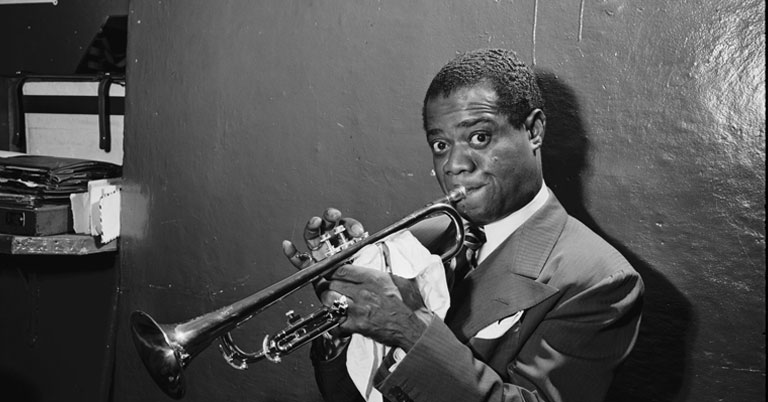In the heart of the Corona neighborhood of Queens, tucked away on a quiet street, lies a mid-century interior design marvel and a testament to the enduring legacy of a jazz legend – the Louis Armstrong House Museum. From its humble brick facade, you’d never guess the rich cultural treasure that lies within.
The museum has recently grown with the addition of the Louis Armstrong Center. This architectural prodigy is a fusion of modern aesthetics and historical reverence, standing out amidst the residential landscape like a 1960s spaceship gently alighting on a suburban street. With a gentle curve to its roof and a brass façade that shimmers in the sunlight, the center seeks to encapsulate the community around it, aiming to connect Armstrong’s cultural legacy to fans, artists, historians, and his beloved Queens community.
The Louis Armstrong Center, according to Regina Bain, the executive director of both the museum and the center, was designed to encompass the larger-than-life legacy of Armstrong. “The house is relatively small,” Bain said, “but his legacy is humongous.” She considers the new center the launchpad for that legacy.
After 25 years in development, the Louis Armstrong Center features diverse spaces for exhibitions, research, education, and live performances. It stands as a unique landmark in the jazz world, according to jazz pianist and composer Jason Moran, who was the center’s inaugural exhibition curator. For Moran, the center represents an opportunity to explore and sustain an artist’s history and to inspire a community that might be indifferent to the art but might care about the underlying cultural significance.
The center is an architectural brainchild of Sara Caples and Everardo Jefferson, who crafted a tribute to Armstrong by uniting two structures – the center and the Armstrong House Museum located across the street – under a singularly inspiring spirit. They drew inspiration from Armstrong’s music and his roots, aiming to reflect the popular creation of jazz that revolutionized culture.
The front of the center is rounded to echo the Armstrong house, with its brass curtain mirroring the color of Armstrong’s trumpet. The building’s entrance cleverly incorporates the notes of Armstrong’s celebrated songs, such as “What a Wonderful World” and “Dinah.” The design also infuses the joy and positivity radiated by Armstrong’s music.
Spanning across a former parking lot, the $26 million center is home to Armstrong’s 60,000-piece archive, including 700 tapes that were previously stored at Queens College. From this collection, Moran has curated the first permanent exhibition titled “Here to Stay,” featuring a rich multimedia and interactive presentation of Armstrong’s life and career.
From Armstrong’s gold-plated trumpet to his unique collage art, the exhibition showcases the vibrant tapestry of Armstrong’s life. His evolution from a New Orleans-born youth player to a global icon is beautifully displayed in the form of his first and last passports. The exhibition also showcases Armstrong’s private life, including his passion for documenting his journey and interactions with loved ones.
The exhibition additionally provides insights into Armstrong’s creative process, particularly his affinity for collage art. Moran compares Armstrong’s creative journey, from a background player to a defining soloist, to the transformative quality of his collages. The exhibition also includes reflections from artist Lorna Simpson on Armstrong’s collages and how they recontextualize his public life.
The design of the center, inspired by Armstrong’s vibrant personality and his fondness for reflective surfaces, strikes a balance between grandiosity and homeliness. Its intimate jazz club space, bathed in a vibrant red, has already hosted rehearsals for the Newport Jazz Festival’s Armstrong tribute.
The center also serves as a hub for various programming including dance and yoga classes, trumpet lessons, and events that engage the largely Spanish-speaking community. According to Bain, the center draws on the legacy of Louis and Lucille Armstrong, aiming to be a resource for the community.
Since its opening on July 6, the center has seen a surge of visitors from all over the country, exceeding initial estimates. It provides an in-depth insight into the life and legacy of Armstrong, beyond what’s taught in textbooks.
Among Armstrong’s final creations was a handwritten ode to Corona, revealing his contentment with his quiet life there. Moran, who views Armstrong’s uplifting music as a solace during the pandemic, particularly cherishes this piece. He sees Armstrong’s upward-slanting handwriting as an embodiment of the jazz legend’s aspirational outlook towards life. He concludes, “It’s in line with how he holds his trumpet” — pointing up to the sky — “how his eyes look when he plays. It’s a slight thing, but it tells us: this is how he thinks about life.”
Reference: Artdaily.cc
